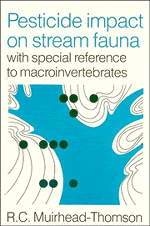Book contents
- Frontmatter
- Contents
- Preface and Acknowledgements
- PART I INTRODUCTION AND ORIGIN OF PESTICIDES IN RUNNING WATERS
- PART II THE ROLE OF LABORATORY AND EXPERIMENTAL METHODS IN EVALUATION
- PART III EVALUATION IN PEST CONTROL PROJECTS
- SIX Introduction to field sampling of aquatic macroinvertebrates in streams and rivers
- SEVEN Impact of insecticides used in control of the spruce budworm
- EIGHT Aquatic environmental effects of insecticides used in tsetse fly control
- NINE Effect on non-targets of larvicides applied to running waters for control of blackfly (Simulium) larvae
- TEN Impact of piscicides (and molluscicides)
- ELEVEN Herbicides and aquatic invertebrates
- Summary and assessment
- References
- Index
EIGHT - Aquatic environmental effects of insecticides used in tsetse fly control
Published online by Cambridge University Press: 05 November 2011
- Frontmatter
- Contents
- Preface and Acknowledgements
- PART I INTRODUCTION AND ORIGIN OF PESTICIDES IN RUNNING WATERS
- PART II THE ROLE OF LABORATORY AND EXPERIMENTAL METHODS IN EVALUATION
- PART III EVALUATION IN PEST CONTROL PROJECTS
- SIX Introduction to field sampling of aquatic macroinvertebrates in streams and rivers
- SEVEN Impact of insecticides used in control of the spruce budworm
- EIGHT Aquatic environmental effects of insecticides used in tsetse fly control
- NINE Effect on non-targets of larvicides applied to running waters for control of blackfly (Simulium) larvae
- TEN Impact of piscicides (and molluscicides)
- ELEVEN Herbicides and aquatic invertebrates
- Summary and assessment
- References
- Index
Summary
INTRODUCTION
For many years, control of tsetse fly in Africa was carried out by a variety of methods based on environmental manipulation, such as bush clearing, game exclusion, habitat destruction by burning etc. The choice of methods was mainly determined by the nature of the habitats characteristic of different species of tsetse, and also by whether the objective of these operations was tsetse control or tsetse eradication.
With the advent of the synthetic insecticide DDT and its allies, increasing emphasis has been on the application of insecticide to the tsetse environment either by means of heavy residual dosages to tsetse-resting sites, or by repeated non-residual applications at lower dosage rates (Jordan, 1974). Initially the insecticides of choice were DDT and dieldrin, the latter being favoured because of its higher toxicity to tsetse. However, it was recognised early that such tsetse control measures had a serious immediate effect on wildlife, mammals, birds, reptiles and fish (Graham, 1964). Over the last 20 years therefore, the preferred insecticide for tsetse control has been the allied organochlorine chemical, endosulphan (Thiodan) (Goebel et al., 1982) selected because of its high lethal effect on tsetse combined with less inimical effect on wildlife (Hocking et al., 1966; Park et al., 1972). That period has also been marked by operational changes; insecticides originally applied by means of ground spraying or fogging equipment, are now applied almost entirely from the air, both by fixed-wing planes and by helicopter.
- Type
- Chapter
- Information
- Pesticide Impact on Stream FaunaWith Special Reference to Macroinvertebrates, pp. 161 - 174Publisher: Cambridge University PressPrint publication year: 1987



